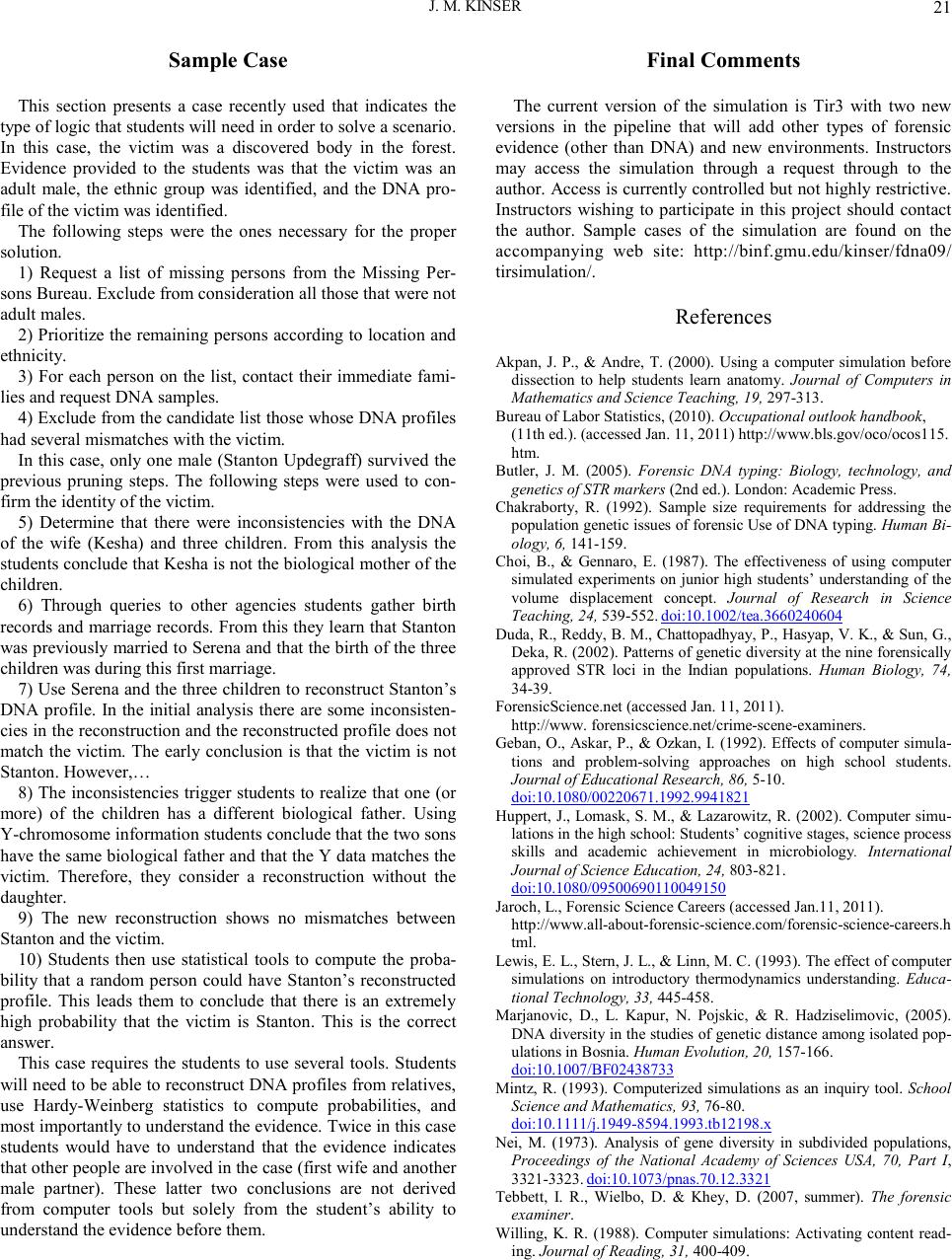
J. M. KINSER
Sample Case
This section presents a case recently used that indicates the
type of logic that students will need in order to solve a scenario .
In this case, the victim was a discovered body in the forest.
Evidence provided to the students was that the victim was an
adult male, the ethnic group was identified, and the DNA pro-
file of the victim was identified.
The following steps were the ones necessary for the proper
solution.
1) Request a list of missing persons from the Missing Per-
sons Bureau. Exclude from consideration all those that were not
adul t males.
2) Prioritize the remaining persons according to location and
ethnicity.
3) For each person on the list, contact their immediate fami-
lies and request DNA samples.
4) Exclude from the candidate list those whose DNA profiles
had several mismatches with the victim.
In th is case, only one male (Stanton Updegraff) survived the
previous pruning steps. The following steps were used to con-
firm the identity of the victim.
5) Determine that there were inconsistencies with the DNA
of the wife (Kesha) and three children. From this analysis the
students conclude that Kesha is not the biological mother of the
children.
6) Through queries to other agencies students gather birth
records and marriage records. From this they learn that Stanton
was previously married to Serena and that the birth of the three
children was during this first marriage.
7) Use Seren a and the thr ee children to reconstru ct Stanton’s
DNA profile. In the initial analysis there are some inconsisten-
cies in the reconstruction and the reconstructed profile does not
match the victim. The early conclusion is that the victim is not
Stanton. However,…
8) Th e inconsistenci es trigger students to realize that one (or
more) of the children has a different biological father. Using
Y-chromosome information students conclude that the two sons
have the sa me bio logical father and that th e Y data matches the
victim. Therefore, they consider a reconstruction without the
daughter.
9) The new reconstruction shows no mismatches between
Stanton and the victim.
10) Students then use statistical tools to compute the proba-
bility that a random person could have Stanton’s reconstructed
profile. This leads them to conclude that there is an extremely
high probability that the victim is Stanton. This is the correct
answer.
This case requires the students to use several tools. Students
will need to be able to reconstruct DNA profiles from relatives,
use Hardy-Weinberg statistics to compute probabilities, and
most importantly to understand the evidence. Twice in this case
students would have to understand that the evidence indicates
that oth er peop le are invo lved in the case ( first wi fe and ano th er
male partner). These latter two conclusions are not derived
from computer tools but solely from the student’s ability to
understand the evidence before t hem.
Final Comments
The current version of the simulation is Tir3 with two new
versions in the pipeline that will add other types of forensic
evidence (other than DNA) and new environments. Instructors
may access the simulation through a request through to the
author. Access is currently controlled but not highly restrictive.
Instructors wishing to participate in this project should contact
the author. Sample cases of the simulation are found on the
accompanying web site: http://binf.gmu.edu/kinser/fdna09/
tirsimulation/.
References
Akpan, J. P., & Andre, T. (2000). Using a computer simulation before
dissection to help students learn anatomy. Journal of Computers in
Mathe matics and Science Teaching, 19, 297-313.
Bureau of Labor Statistics, (2010). Occupational outlook ha ndbook,
(11th ed.). ( acce s se d J a n. 1 1, 201 1) http://www.bls. gov/oco/ocos 115.
htm.
Butler, J. M. (2005). Forensic DNA typing: Biology, technology, and
gene tics of ST R markers (2nd ed.). London: Academic Press.
Chakraborty, R. (1992). Sample size requirements for addressing the
popula tion geneti c issues of forens ic Use of DNA typing. Human Bi-
ology, 6, 141-159.
Choi, B., & Gennaro, E. (1987). The effectiveness of using computer
simulated experiments on junior high students’ understanding of the
volume displacement concept. Journal of Research in Science
Teaching, 24, 539-552. doi:10.1002/tea.3660240604
Duda, R., Reddy, B. M., Chattopadhyay, P., Hasyap, V. K. , & Sun, G. ,
Deka, R. (20 02). Patt erns of genetic diversity at the nine forensically
approved STR loci in the Indian populati ons . Human Biology, 74,
34-39.
ForensicScience.net (accessed Jan. 11, 2011).
http://www. forensicscience.net/crime-scene-examiners.
Geban, O., Askar, P., & Ozkan, I. (1992). Effects of computer simula-
tions and problem-solving approaches on high school students.
Journal of Educational Research, 86, 5-10.
Huppert, J., Lomask, S. M., & Lazarowitz, R. (2002). Computer simu-
lati ons in the hi gh sch ool: St uden t s’ cognit i ve stages, sc i ence process
skills and academic achievement in microbiology. International
Journal of Scie nce Ed ucat io n, 24, 803-821.
doi:10.1080/00220671.199 2.9941821
doi:10.1080/09500690110049150
Jaroch , L., Forensic Science Careers (accessed Ja n .11, 2011).
http://www.all-about-forensic-science.com/forensic-science-careers.h
tml.
Lewis, E. L., Stern, J. L., & Linn, M. C. (1993). The effect of computer
simulations on introductory thermodynamics understanding. Educa-
tional Technology, 33, 445 -458.
Marjanovic, D., L. Kapur, N. Pojskic, & R. Hadziselimovic, (2005).
DNA diversity in the studies of genetic distance among isolated pop-
ulations in Bosnia. Huma n E vol ut ion, 20 , 157-166.
doi:10.1007/BF02438733
Mint z, R. (1993 ). Computerized simulation s as an i nquiry tool. School
Science and Mathematics, 93, 76-80.
doi:10.1111/j.1949-8594.1993.tb12 198.x
Nei, M. (1973). Analysis of gene diversity in subdivided populations,
Proceedings of the National Academy of Sciences USA, 70, Part I,
3321-3323. doi:1 0.1073/pna s .70.12.3321
Tebbett, I. R., Wielbo, D. & Khey, D. (2007, summer). The forensic
examiner.
Willing, K. R. (1988). Computer simulations: Activating content read-
ing. Journal of Reading, 31, 400-409.